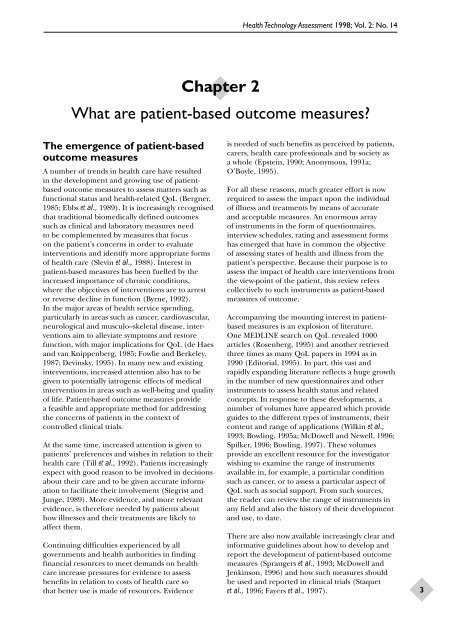Evaluating Patient-Based Outcome Measures - NIHR Health ...
Evaluating Patient-Based Outcome Measures - NIHR Health ...
Evaluating Patient-Based Outcome Measures - NIHR Health ...
Create successful ePaper yourself
Turn your PDF publications into a flip-book with our unique Google optimized e-Paper software.
The emergence of patient-based<br />
outcome measures<br />
A number of trends in health care have resulted<br />
in the development and growing use of patientbased<br />
outcome measures to assess matters such as<br />
functional status and health-related QoL (Bergner,<br />
1985; Ebbs et al., 1989). It is increasingly recognised<br />
that traditional biomedically defined outcomes<br />
such as clinical and laboratory measures need<br />
to be complemented by measures that focus<br />
on the patient’s concerns in order to evaluate<br />
interventions and identify more appropriate forms<br />
of health care (Slevin et al., 1988). Interest in<br />
patient-based measures has been fuelled by the<br />
increased importance of chronic conditions,<br />
where the objectives of interventions are to arrest<br />
or reverse decline in function (Byrne, 1992).<br />
In the major areas of health service spending,<br />
particularly in areas such as cancer, cardiovascular,<br />
neurological and musculo–skeletal disease, interventions<br />
aim to alleviate symptoms and restore<br />
function, with major implications for QoL (de Haes<br />
and van Knippenberg, 1985; Fowlie and Berkeley,<br />
1987; Devinsky, 1995). In many new and existing<br />
interventions, increased attention also has to be<br />
given to potentially iatrogenic effects of medical<br />
interventions in areas such as well-being and quality<br />
of life. <strong>Patient</strong>-based outcome measures provide<br />
a feasible and appropriate method for addressing<br />
the concerns of patients in the context of<br />
controlled clinical trials.<br />
At the same time, increased attention is given to<br />
patients’ preferences and wishes in relation to their<br />
health care (Till et al., 1992). <strong>Patient</strong>s increasingly<br />
expect with good reason to be involved in decisions<br />
about their care and to be given accurate information<br />
to facilitate their involvement (Siegrist and<br />
Junge, 1989). More evidence, and more relevant<br />
evidence, is therefore needed by patients about<br />
how illnesses and their treatments are likely to<br />
affect them.<br />
Continuing difficulties experienced by all<br />
governments and health authorities in finding<br />
financial resources to meet demands on health<br />
care increase pressures for evidence to assess<br />
benefits in relation to costs of health care so<br />
that better use is made of resources. Evidence<br />
Chapter 2<br />
<strong>Health</strong> Technology Assessment 1998; Vol. 2: No. 14<br />
What are patient-based outcome measures?<br />
is needed of such benefits as perceived by patients,<br />
carers, health care professionals and by society as<br />
a whole (Epstein, 1990; Anonymous, 1991a;<br />
O’Boyle, 1995).<br />
For all these reasons, much greater effort is now<br />
required to assess the impact upon the individual<br />
of illness and treatments by means of accurate<br />
and acceptable measures. An enormous array<br />
of instruments in the form of questionnaires,<br />
interview schedules, rating and assessment forms<br />
has emerged that have in common the objective<br />
of assessing states of health and illness from the<br />
patient’s perspective. Because their purpose is to<br />
assess the impact of health care interventions from<br />
the view-point of the patient, this review refers<br />
collectively to such instruments as patient-based<br />
measures of outcome.<br />
Accompanying the mounting interest in patientbased<br />
measures is an explosion of literature.<br />
One MEDLINE search on QoL revealed 1000<br />
articles (Rosenberg, 1995) and another retrieved<br />
three times as many QoL papers in 1994 as in<br />
1990 (Editorial, 1995). In part, this vast and<br />
rapidly expanding literature reflects a huge growth<br />
in the number of new questionnaires and other<br />
instruments to assess health status and related<br />
concepts. In response to these developments, a<br />
number of volumes have appeared which provide<br />
guides to the different types of instruments, their<br />
content and range of applications (Wilkin et al.,<br />
1993; Bowling, 1995a; McDowell and Newell, 1996;<br />
Spilker, 1996; Bowling, 1997). These volumes<br />
provide an excellent resource for the investigator<br />
wishing to examine the range of instruments<br />
available in, for example, a particular condition<br />
such as cancer, or to assess a particular aspect of<br />
QoL such as social support. From such sources,<br />
the reader can review the range of instruments in<br />
any field and also the history of their development<br />
and use, to date.<br />
There are also now available increasingly clear and<br />
informative guidelines about how to develop and<br />
report the development of patient-based outcome<br />
measures (Sprangers et al., 1993; McDowell and<br />
Jenkinson, 1996) and how such measures should<br />
be used and reported in clinical trials (Staquet<br />
et al., 1996; Fayers et al., 1997).<br />
3
















